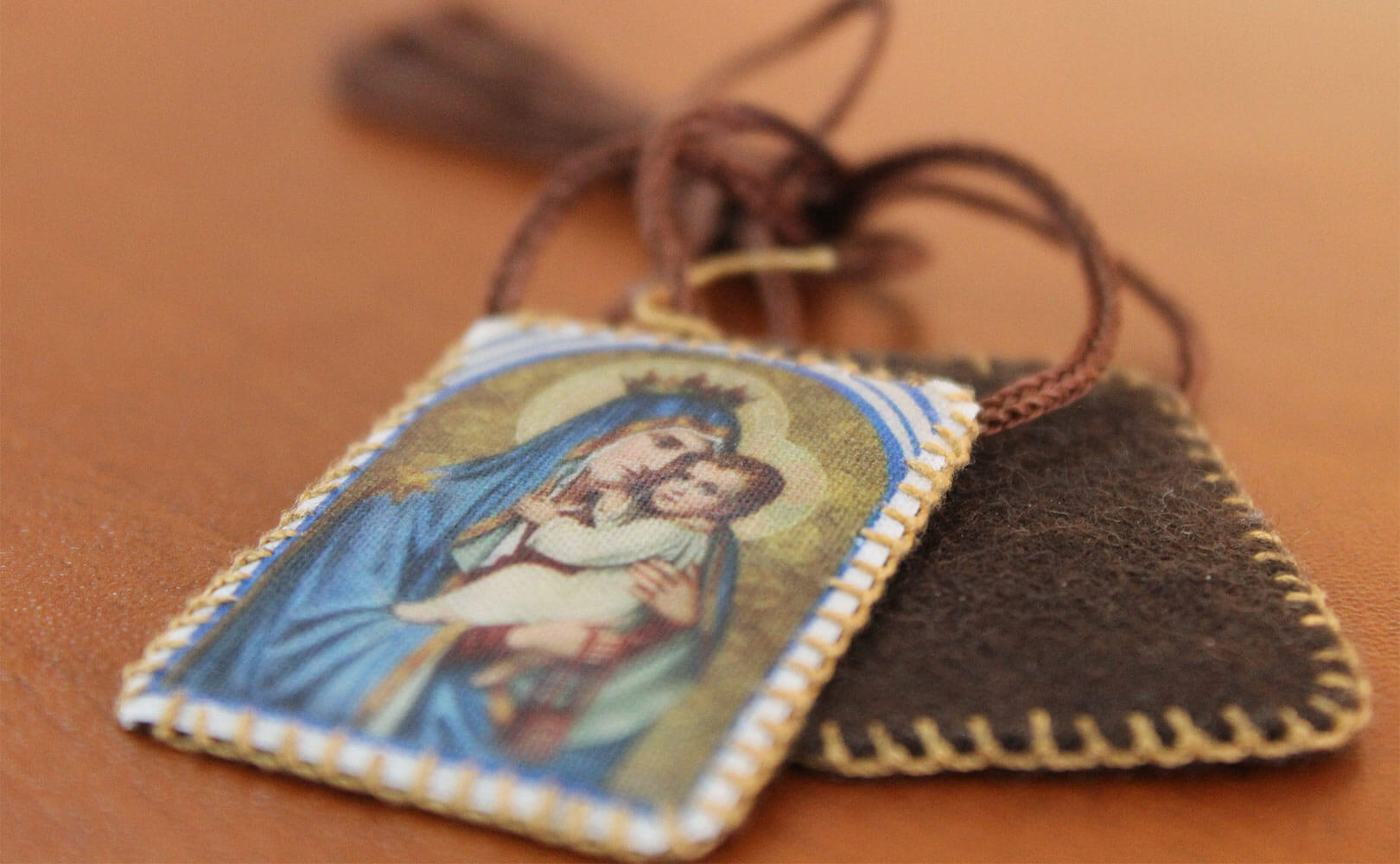In the mid-1240s, the Carmelite order left Mt. Carmel for England because of persecution from the Saracens. The Carmelites were small in number before migrating to Europe, and now the order appeared to be on the verge of extinction as some opted not to make the journey. The Carmelites faced further hardships in their new location, where they were met with bishops and other clergy who thought that the order should be suppressed. In 1251, St. Simon Stock, the then superior general of the Carmelite Order, was very concerned about the future. On July 16 of the same year, he was praying and fasting, asking Mary “by some sign of grace” to show her maternal care and protection of the Carmelites. Our Lady of Mt. Carmel then appeared to St. Simon with a brown scapular in her hand. Mary said to him, “Take this scapular, it shall be a sign of salvation, a protection in danger, and a pledge of peace. Whosoever dies wearing this scapular shall not suffer eternal fire.”[1]
Before referencing some of the popes and saints who promoted the scapular and its associated promises, it would be good to ponder the reasonableness of the devotion. Imagine if someone decided that they wanted to honor you by wearing a photo of you on a necklace day and night, year after year. Suppose they regularly kissed the image with love before going to bed. You would be quite touched by these actions and would want to support such a person in any way you could. Mary’s immaculate heart, full of goodness and love, is moved by her children wearing the scapular in her honor. While we are weak and have limitations which may prevent us from lending as much aid as we would sometimes like to those who are dear to us, Mary is, as her litany teaches us, most powerful. As the Queen of Heaven and Earth, Mary can use her power to ensure that the faithful devotees of her scapular die in the state of grace.
Another motive for giving credibility to the brown scapular devotion is all the miracles wrought through the scapular. St. Augustine once wrote, “It would be against all divine attributes for God to approve a lie with miracles.” St. Claude de la Colombiere wrote, “I venture to say that among all the pious devotions of the faithful to honor the Mother of God, there is no other so safe as devotion to her scapular, since no other has been confirmed by such wonderful and authentic miracles.”[2]
This sermon posted on the Sensus Fidelium channel includes some awesome scapular miracle stories. My favorite one being of the scapular wearing American soldier who had a significant part of his head taken off by a bullet during World War II and yet lived long enough to have a priest come hear his confession. Another great story is of the scapular wearing man in Ashtabula, Ohio who, while on a railroad track, was split in half by a train, also staying alive long enough to have a priest come hear his confession.
Lest anyone think that someone can get away with abusing the scapular, there is the story of the impenitent habitual sinner who begged the hospital nurses to take off his scapular because it was “burning him,” and then died soon after the scapular was removed.
In addition to the promise to be saved from hell, there is another major brown scapular privilege, the Sabbatine Privilege, which was first made known in a bull written by Pope John XXII in 1322. Pope Paul V also composed a decree on the Sabbatine Privilege in which he wrote, “The Blessed Virgin will assist by her continual intercession, suffrages and merits, and also by her special protection, particularly on the Saturday after death, the souls of the members of the [Scapular] Confraternity departing this life in charity who shall have worn the scapular, observed chastity according to their particular state of life, and also have recited the Little Office, and have abstained from the use of meat on Wednesdays and Saturdays.”[3] There are possible commutations to some of these requirements. Anyone interested in commutations should consult a respected priest.
The Sabbatine Privilege has been explicitly confirmed by Clement VII, St. Pius V, Gregory XIII, Paul V, and St. Pius X.[4] St. John of the Cross was referring to his hope in this privilege when he told his brothers that he would consider it a great grace from Our Lady to die on a Saturday.
St. Alphonsus Liguori is another saint who had a particular devotion to the brown scapular. “Just as men” St. Alphonsus writes, “take pride in having others wear their livery, so the most holy Mary is pleased when her servants wear he scapular as a mark that they have dedicated themselves to her.” When St. Alphonsus’ body was exhumed a few years after his death, it was found that his body and episcopal robes had decomposed, but his scapular lay incorrupt.[5] St. John Bosco’s scapular was also discovered to be incorrupt while his tomb was opened as part of the examination before his beatification. St. Peter Claver, cognizant that the Africans he baptized would likely be deprived of further instruction and the help of priests, gave to each convert a brown scapular as a way of entrusting them to Mary’s powerful, maternal care.
Our Lady of Fatima concluded her final apparition on October 13 by appearing as Our Lady of Mt. Carmel. Sr. Lucy of Fatima commented, “Our Lady held the scapular in her hands because she wants us all to wear it.”
NOTES:
[1] Carmelite Fathers and Tertiaries. Take This Scapular: Commemorating the Seventh Centenary of the Scapular. The Carmelite Third Order Press: Chicago, 1949. Pg. 12
[2] Ibid. Pg. 41
[3] Ibid. Pg. 55
[4] Ibid. Pg. 54
[5] Ibid. Pg. 66


